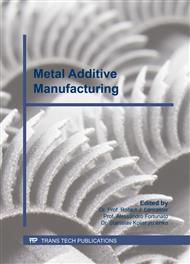[1]
C. Körner, Additive manufacturing of metallic components by selective electron beam melting – a review, International Materials Reviews (2016), 61:5, 361-377.
DOI: 10.1080/09506608.2016.1176289
Google Scholar
[2]
J. R. Davis, ASM specialty handbook: nickel, cobalt, and their alloys, ASM International, USA, (2000).
Google Scholar
[3]
D. Eskin and L. Katgerman, Mechanical properties in the semi-solid state and hot tearing of aluminium alloys, Progress in Materials Science. 49 (2004), 629-711.
DOI: 10.1016/s0079-6425(03)00037-9
Google Scholar
[4]
S. Kou, Solidification and liquation cracking issues in welding, JOM. 55 (2003), 37-42.
DOI: 10.1007/s11837-003-0137-4
Google Scholar
[5]
L. N. Carter, M. M. Attallah, and R. C. Reed, Laser powder bed fabrication of nickel-base superalloys: influence of parameters; characterisation, quantification and mitigation of cracking, Superalloys (2012), 577-586.
DOI: 10.1002/9781118516430.ch64
Google Scholar
[6]
Y. Chen, K. Zhang, J. Huang, S. R. E. Hosseini, and Z. Li, Characterization of heat affected zone liquation cracking in laser additive manufacturing of Inconel 718, Materials & Design. 90 (2016), 586-594.
DOI: 10.1016/j.matdes.2015.10.155
Google Scholar
[7]
M. L. Montero Sistiaga, R. Mertens, B. Vrancken, X. Wang, B. Van Hooreweder, J.-P. Kruth, and J. Van Humbeeck, Changing the alloy composition of Al7075 for better processability by selective laser melting, Journal of Materials Processing Tech. 238 (2016), 437-445.
DOI: 10.1016/j.jmatprotec.2016.08.003
Google Scholar
[8]
M. Cloots, P. J. Uggowitzer, and K. Wegener, Investigations on the microstructure and crack formation of IN738LC samples processed by selective laser melting using Gaussian and doughnut profiles, Materials & Design. 89 (2016), 770-784.
DOI: 10.1016/j.matdes.2015.10.027
Google Scholar
[9]
B. Ruttert, M. Ramsperger, L. M. Roncery, I. Lopez-Galilea, C. Körner, and W. Theisen, Impact of hot isostatic pressing on microstructures of CMSX-4 Ni-base superalloy fabricated by selective electron beam melting, Materials & Design. 110 (2016), 720-727.
DOI: 10.1016/j.matdes.2016.08.041
Google Scholar
[10]
M. Ramsperger, R. F. Singer, and C. Körner, Microstructure of the Nickel-Base Superalloy CMSX-4 Fabricated by Selective Electron Beam Melting, Metallurgical and Materials Transactions A: Physical Metallurgy and Materials Science. 47 (2016), 1469-1480.
DOI: 10.1007/s11661-015-3300-y
Google Scholar
[11]
Z. W. Chen, M. A. L. Phan and K. Darvish, Grain growth during selective laser melting of a Co-Cr-Mo alloy, Journal of Materials Science. 52 (2017), 7415-7427.
DOI: 10.1007/s10853-017-0975-z
Google Scholar
[12]
C. Körner, H. Helmer, A. Bauereiß and R. F. Singer, Tailoring the grain structure of IN718 during selective electron beam melting, MATEC Web of Conferences. 14 (2014), 08001.
DOI: 10.1051/matecconf/20141408001
Google Scholar
[13]
P. C. Collins, D. A. Brice, P. Samimi, I. Ghamarian and H. L. Fraser, Microstructure control of additively manufactured metallic materials, Annu. Rev. Mater. Res. 46 (2016), 63-91.
DOI: 10.1146/annurev-matsci-070115-031816
Google Scholar



